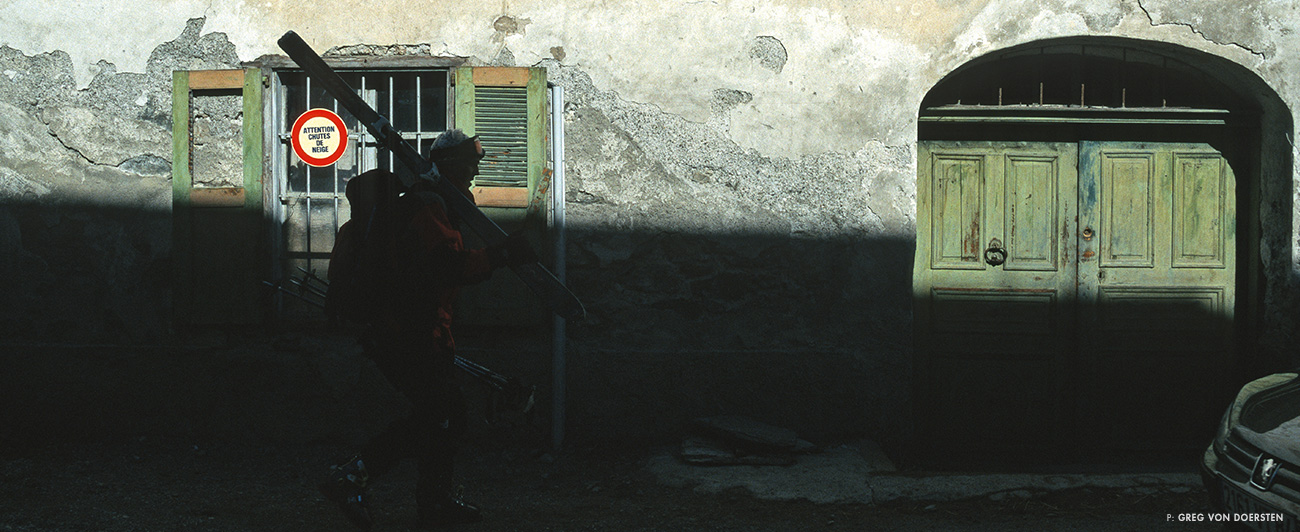Gallerie
Truly Exotic
The Greg Von Doersten Way
This article first appeared in The Ski Journal Issue 15.2
“Nobody can get away with that, and Von Doersten’s there in the underbelly of the airplane getting amazing photographs,” says pro kayaker, Tyler Bradt, who traveled with Von Doersten in 2011 to run the highest-volume rapids on the planet. “He could have just as easily kicked back and gone along for the ride.”
As a kid growing up in Ohio, Von Doersten (known affectionately as “GVD” to everyone who’s met him) obsessed about stories of Sir Ernest Shackleton’s expeditions to Antarctica. For his whole adult life, he’s been telling stories of his own expeditions to exotic and treacherous destinations to far-flung corners of the globe. GVD views his photography as something more than just creating great images. For him, it’s about telling great stories.
Von Doersten rattles off names and dates and mountain ranges from Iran to Alaska with encyclopedic knowledge. He recalls meetings he had with photo editors 30 years before and in the same breath talks of future expeditions. This mile-a-minute mentality is indicative of scrappiness that’s led to a prolific career not only spanning the globe, but also running the gamut of mountain sports and adventure travel.
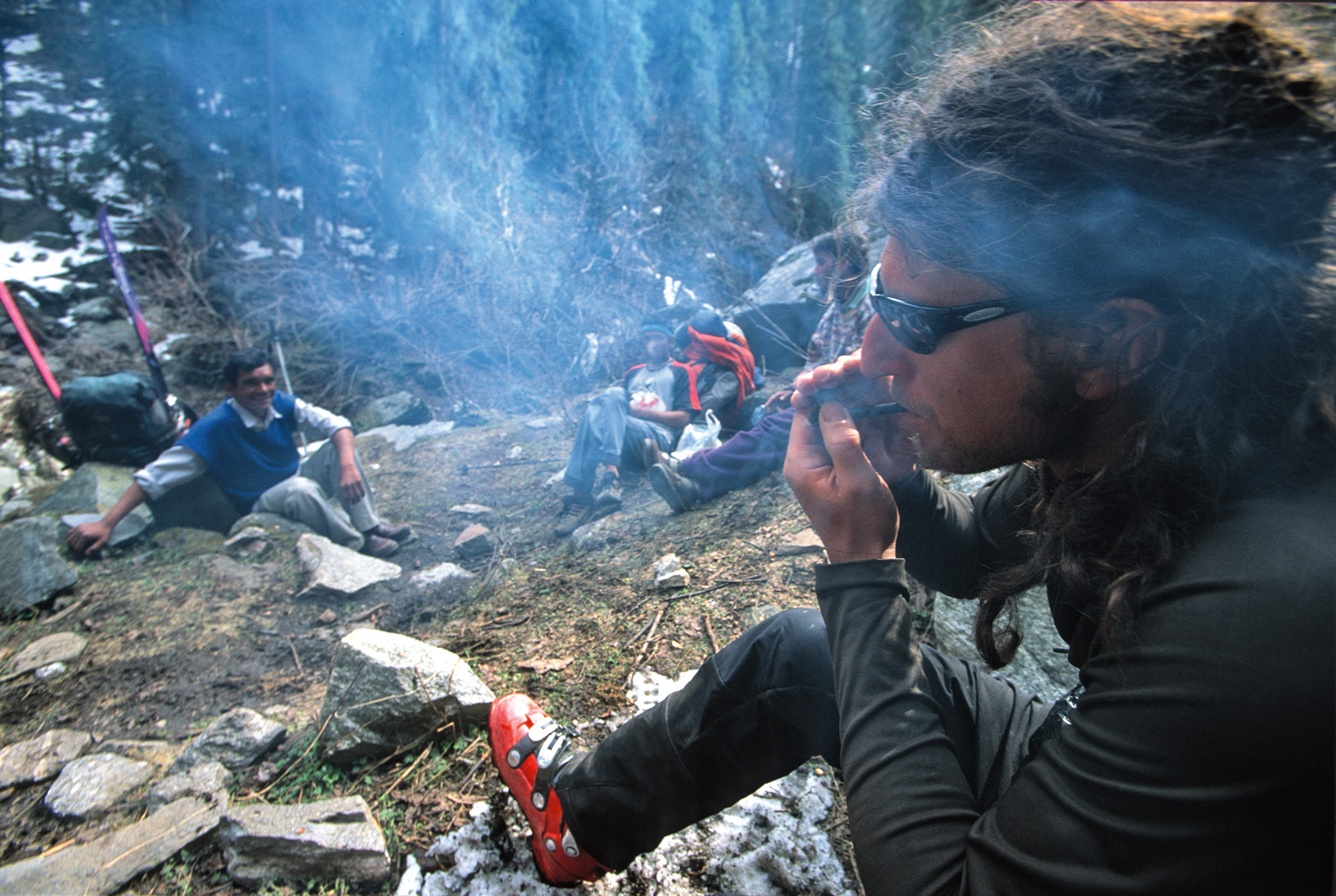
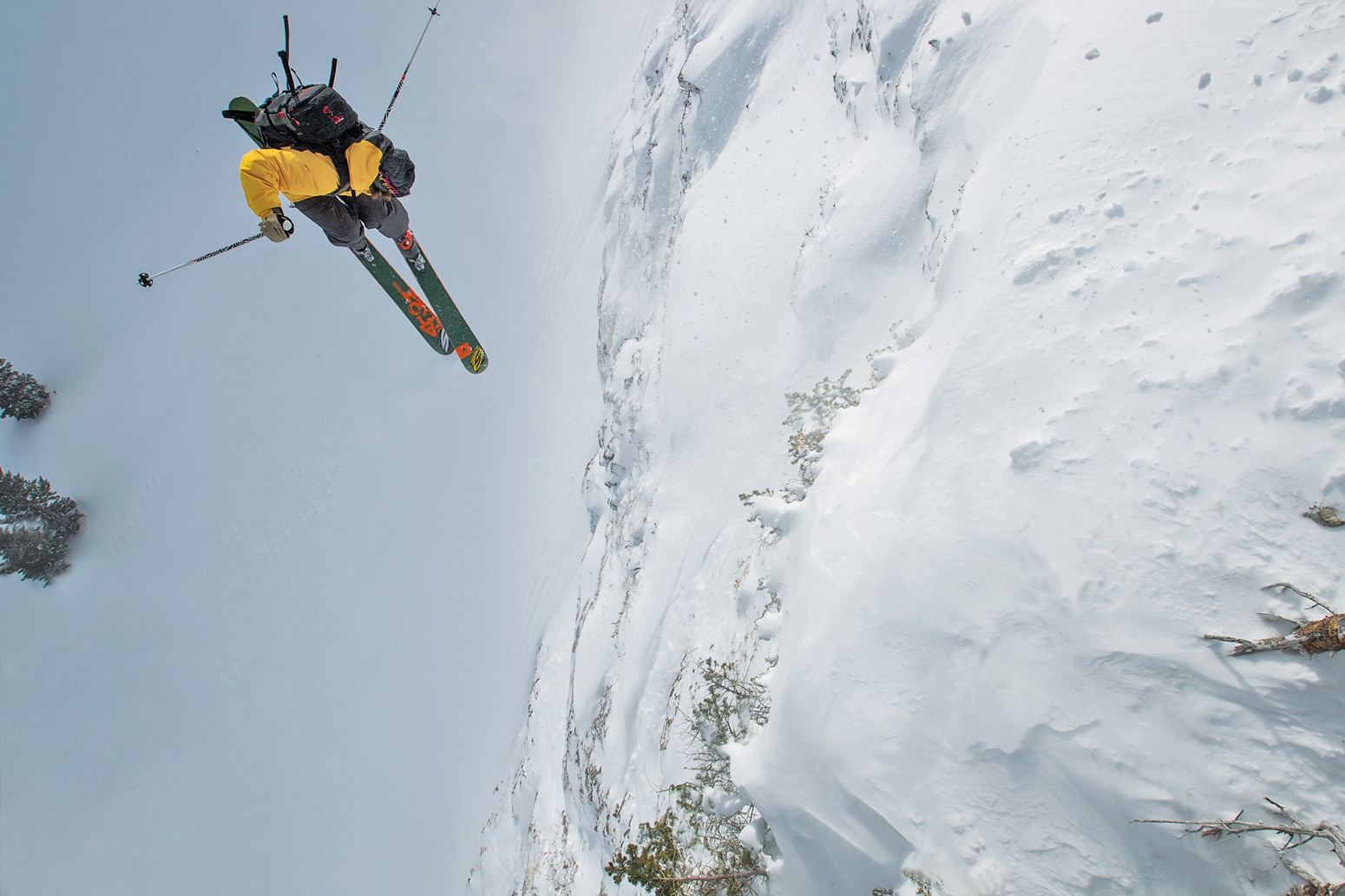
top to bottom
I first met Ptor Spricenieks during the dirtbag days of Chamonix in the early ‘90s. We were living near each other in abandoned forest lean-tos and getting after it on all the big ski mountaineering objectives in the valley. Eventually we started seeking out new, untapped mountain ranges in places like South America and India, places that had very little interest to foreign skiers at the time. Here Spricenieks takes a smoke break with porters in the Jagatsukh Valley, India in May 2004.
Fading light in the Jackson Hole, WY backcountry in January 2014. Laurent De Martin lined up this jump as the day was wrapping up and this POV angle really showed the exposure of the cliff and De Martin’s beautiful style.
Von Doersten first set foot in the Tetons as a 10-year-old kid in the 1970s. Though his father, “Big Ed,” had pointed GVD toward conventional sports, his sights had long been set on the mountains of the West. When he heard about Teton Valley Ranch Camp, a summer camp in Jackson, WY, he focused on outdoor skills like climbing, hiking and horsemanship, pressuring his dad to let him go. On that trip, he fell in love with both Jackson Hole and life in the mountains.
After spending four summers there as a camper and racking up an impressive number of nontechnical peaks, Von Doersten became one of the youngest students admitted to the NOLS advanced mountaineering course at 13 years old. He climbed many of the highest peaks in the Tetons and the Wind River Range, graduating to more challenging routes through his teens. While he took a point-and-shoot camera along with him on many of these trips, it wasn’t until college that his interest in photography really took hold.
At the University of Montana, he studied forestry and recreation management with eyes on becoming a career river or mountain guide. He also took some black-and-white photography classes. He says he inherited artistic flair from his mother, Gigi, who often worked with watercolors and oil paints. From early on she showed Von Doersten the value of creativity and the basic artistic instincts that went on to help his photography—paying attention to light and mood, storytelling through the placement of objects within a frame, and attention to detail.
For his initial big foreign trip, a NOLS course in Africa, Von Doersten received his first SLR camera as a gift. In Africa, he met photographer and writer Ted Kerasote, who inspired the young adventurer. From there, Von Doersten began teaching himself how to shoot.
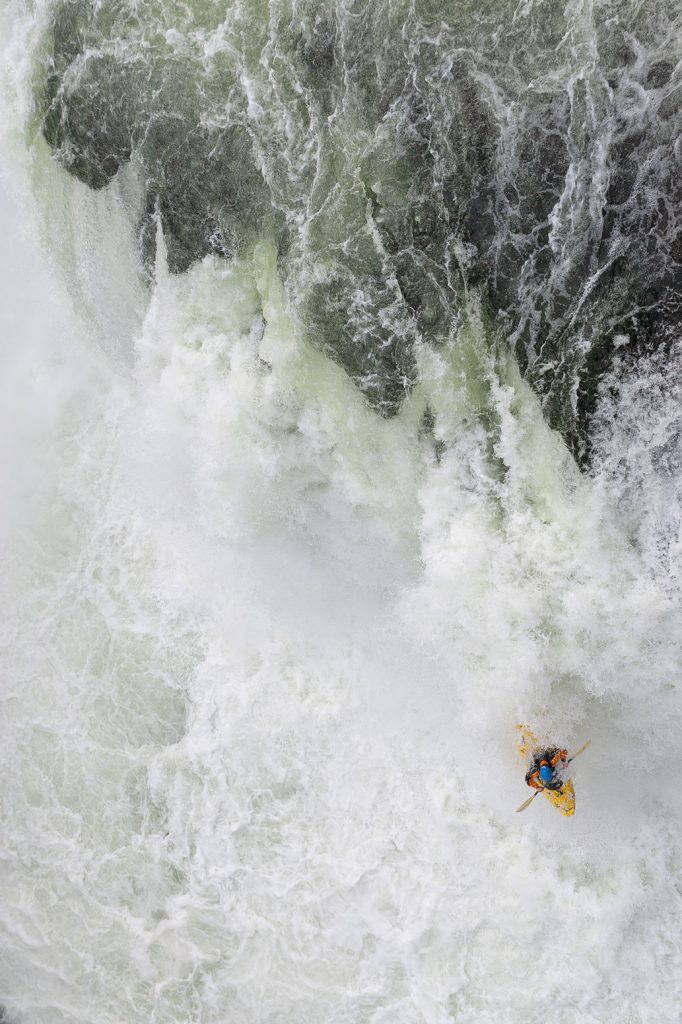
In July 2015, before drones ruled the skies, I looked to land-based features to give a unique aerial perspective. Tyler Martin runs the Class V Lower Mesa Falls on Henrys Fork of the Snake River, ID.
By the late ’80s, Von Doersten was back in Jackson living part-time in an infamous ski-bum cabin called the Simpson House for $89.99 a month. His roommates ranged from dumpster-diving misfits to acclaimed adventurers like Stephen Koch, Mark Newcomb, Julie Zell and Doug Workman, who profiled their ski-bum palace in Powder Magazine.
About this time, Von Doersten began stashing his possessions in the Simpson House basement and taking extended trips to Europe. Long trips to Chamonix and Norway, guiding on the rivers and in the mountains while spending his free time with world-class athletes in sports from skiing and snowboarding to base jumping and paragliding. He’d hang out with such guys as pro snowboarder Jay Nelson, UIAGM guide Bernd Schulke and extreme snowboarders Jerome Ruby and Dédé Rhem, carving his photography hobby into a burgeoning career. When guiding was slow, he’d take odd jobs to support expeditions, or throw trips together by finding last-minute athletes and sponsor travel budgets—always shooting photos for his ever-expanding portfolio.
His first big break came when the infamous Colonel Narendra “Bull” Kumar hired him to guide and shoot a river expedition in India and Nepal, traveling from the source of the Ganges in the Himalaya to the Bay of Bengal. This led to some of Von Doersten’s first published images in trade magazines and publications such as Paddler Magazine and Canoe and Kayak. About this time, his ski photography started making print, too.
Von Doersten looked up to adventure photographers like Ned Gillette and Galen Rowell, dogged hustlers known for their tenacity in chasing down sponsorships for huge expeditions.
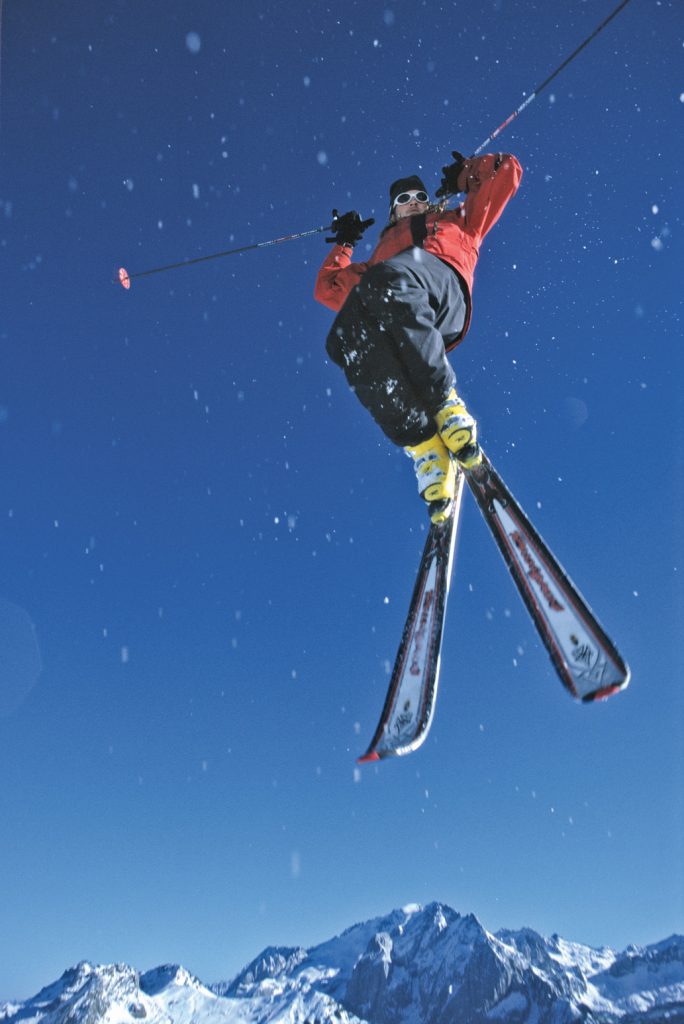

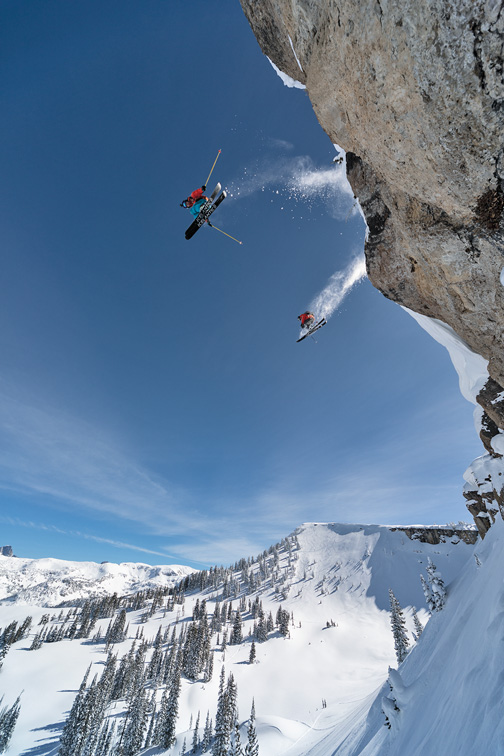
top to bottom
One of the original TGR athletes, Micah Black would become a huge influence for local skiers in Jackson and around the world with his aggressive and hard-charging style. Micah throwing a 360 tip cross at Passo Pordoi, Italy in March 1998.
Skier Dave Steiner and TGR founder and cameraman Todd Jones gear up for a film shoot in Teton Pass, WY with the infamous “Tangerine Dream,” a derelict Dodge RAM Power wagon that has been TGR’s production vehicle since the early ’90s.
March 2018 was one for the record book in Idaho with an insane 50-inch, three-day storm. I got a call from Julian Carr, who was game to test the deep landings around Caribou-Targhee with fellow high-flier Owen Leeper. After a few single airs, I suggested we attempt a duo jump to mix things up. They synched the inrun and both had good form.
“Similar to Gillette and Rowell, I became friends with athletes and climbers,” Von Doersten says. “I was very comfortable with high-angle terrain and rope work, and just being able to hang with the crew.” All of that time in high places gave Von Doersten a chance to craft stories with the athletes themselves, as well as start to build his own narratives behind the lens.
He brought his first high-end camera, a Nikon F4, to Chamonix in the late ’80s and began spending less time guiding and more time shooting photos. In Chamonix, he got a shot of snowboarder Dave Seoane tweaking a grab against a backdrop of royal blue sky far above a horizon of the Alps. The photo not only found the cover of the young and independent sNo Board magazine, but it was also licensed to an East Coast ad agency back in the age of rights-managed photography. They paid him $35,000—still one of the largest sales of his career—and his photo was featured in the 1989 international ad campaign for Molson Ice.
Von Doersten describes this sale as surreal; he used some of the money to fund new equipment, but more importantly it gave him confidence that he had both the talent to create great imagery and the negotiating skills to make real money selling photos to big clients.
In the early ’90s, Von Doersten began working with Marmot, one of big mountain legend Doug Coombs’ major sponsors, and accompanied Coombs on climbs in the Tetons and heli-skiing in Alaska. Renowned adventure photographer Ace Kvale also shot for Marmot during that time and took the young Von Doersten under his wing.
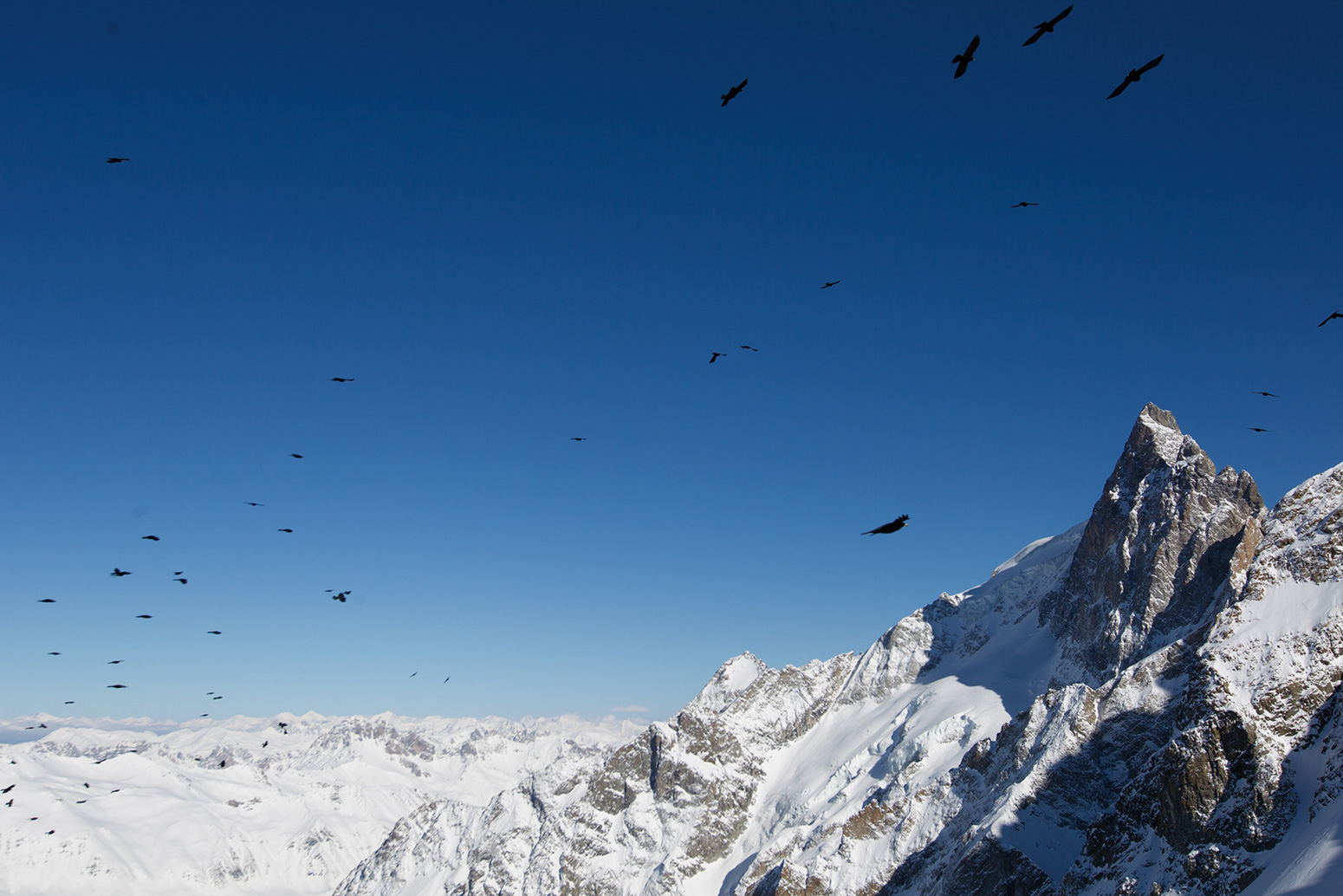
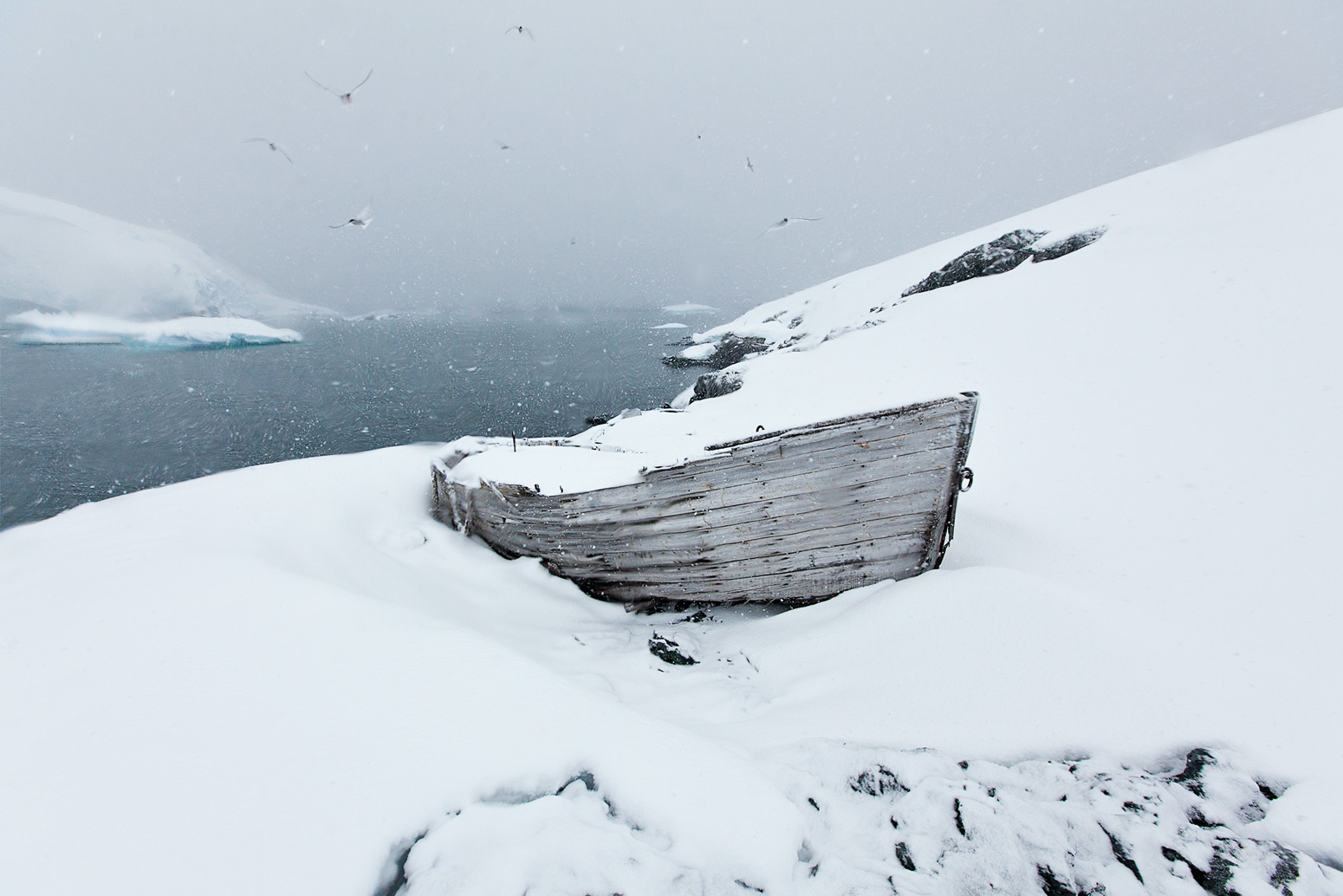
top to bottom
I’ve been visiting the mountains of Europe for over half my life. They are special, and bring back a mix of joy and sadness. Choucas are the predominate black bird in the Alps and play a folkloric role as the spirit of fallen comrades in the mountains. I have shot hundreds of photos of them and always feel a connection with friends lost and the moments we shared. La Grave, France.
Sometimes the most amazing discoveries are found on layover days when the weather is overcast and the snow is blowing sideways. On a solo kayak excursion, I found this derelict whaling harpoon boat from the 18th century located near Enterprise Island off the coast of Antarctica, capturing this image while being harassed by a flock of Arctic terns.
“GVD is always driven,” Kvale says. “Driven to produce cutting-edge photos, working to get that angle, to get the shot for his editors and for his own self-motivation. He’s not a spectator; he’s a participant in his own photos and expeditions.”
In pitching stories and expeditions, Von Doersten began looking off the beaten path for compelling stories. He favored smaller teams with more modest budgets over high-profile expeditions.
“If you’re just executing the sea of sameness in the same location over and over again and getting pretty shots, that’s great. But that’s not how I view my job,” Von Doersten says. “That’s not how you continue to craft that iconic stuff.”
That stuff, he says, comes from dynamic light, unique angles and locations, subjects interacting with the natural world in interesting ways and, most importantly, images that tell stories.
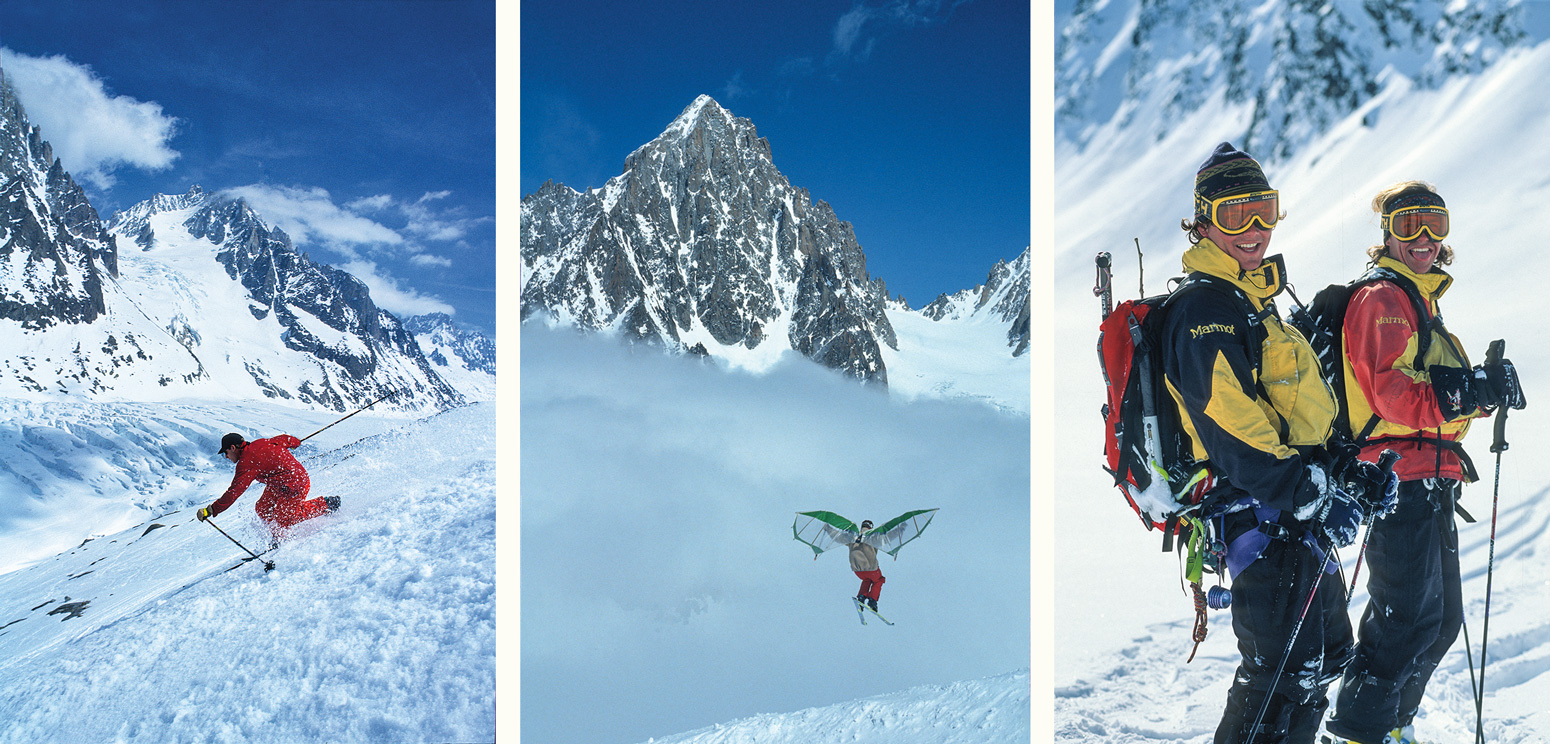
left to right
Grand Montets, Chamonix, France. Of all of the friends I had the opportunity to ski with in Chamonix, good friend and mad telemark skier Francois de Pfyffer had the greatest “fun factor.” Francois had incredible form on telemark or downhill skis and was always up to collaborate on crazy ideas when I was starting my photography career. We would go on to to make a number of first descents on telemarking skis and produced some great work for Patagonia during our tenure working together.
Steve and Todd Jones, cofounders and co-owners of Teton Gravity Research in the Valley of the Tusk, in the early ’90s near Valdez, AK. The operation has gotten a little more professional since then, but the enthusiasm for this special collection of mountains has never waned.
My good friend Francois de Pfyffers made these flying wings from sail board cloth. Patagonia ran with the shot in its ads, including a classic, “Lunacy is the mother of invention.” De Pfyffer trying out his contraption in Les Grand Montes, France in April 2000.
By the mid ’90s Von Doersten was publishing work with such magazines as Men’s Journal, Outside, and National Geographic Adventurer and had established what would become long-term relationships with brands such as The North Face and Patagonia. His work took him all over the world, and across disciplines. Jane Sievert, longtime friend and photo editor at Patagonia, says Von Doersten has the rare ability to shoot any sport successfully—on skis, by boat, or from a climbing rope.
“He really hangs it out there on some big expeditions,” Sievert says. “He has such a great range of photography from underwater tropical, to the Grand Canyon, to deep powder, to beautiful scenes from Antarctica.”
That breadth of work, she remembers, always occupied a massive physical portfolio, a beautiful handcrafted work of art in itself Von Doersten carried around the halls of the SIA trade show (now Outdoor Retailer) as he spoke with brand reps, athletes and photographer friends. He knew the value of his work and that of his colleagues.
“He’s always been a strong advocate for photographers and a bit of a pain in the ass,” Sievert says. “But he really negotiated with photo editors and buyers. His goal was to open the eyes of the outdoor industry to the risk and difficulty and value of the images these guys were creating. I think he can take credit for elevating that discussion, for sure.”
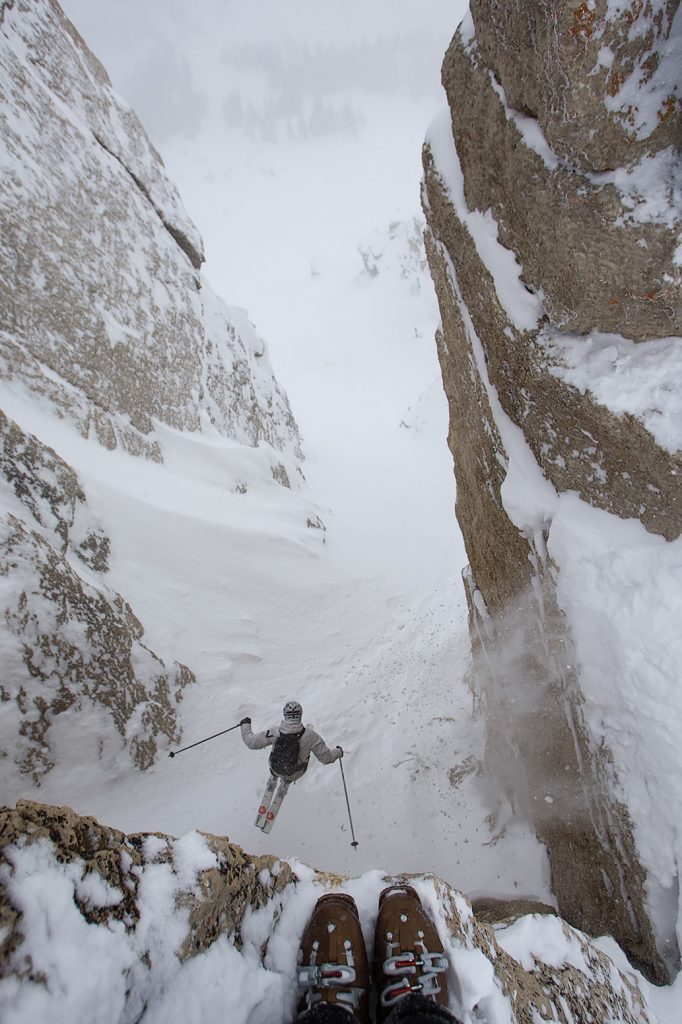
I’m always trying to bring a unique perspective to iconic locations that have already been shot by many of my fellow lensmen. TGR cameraman Josh Nielsen had the primary angle on this day in February 2009, so I decided to mix it up with a POV angle while Shroder Baker “acid dropped” into the infamous S&S Couloir at Jackson Hole, WY.
During Von Doersten’s time as an up-and-coming young photographer, Jackson was the ideal place to call home.
At the time, it was the epicenter of ski alpinism in America and, in addition to athletes like Doug Coombs and Stephen Koch, Jackson connected him to other creative types who helped him hone his craft. He met, befriended and started working with Steve, Todd and Jeremy Jones just before Steve and Todd started Teton Gravity Research. It was Von Doersten who pitched and shot a “Keeping up with the Joneses” ad campaign, pre-TGR, for Rossignol in Valdez.
“GVD just has a super-good eye and was always pretty bulldoggish to get his vision,” Todd says. “It’s a ferocity. He’ll see a shot and have an idea, sit on it, wait and wait, and grind it out to try to get that particular shot.”
Their friendship, though, runs deeper than that. It’s based on mutual admiration for deep adventure off the beaten path, the “truly exotic” as Steve describes it. Together they’ve travelled and shot in locations from Corsica, to India, to Norway, trips that really highlighted Von Doersten’s curiosity behind the lens.
“Von Doersten is one of those people that really takes time to respect cultures instead of just moving through them passively,” Steve says. “He wants to immerse himself in it and really experience it—not just go there to rip a line and get a couple sick shots.”
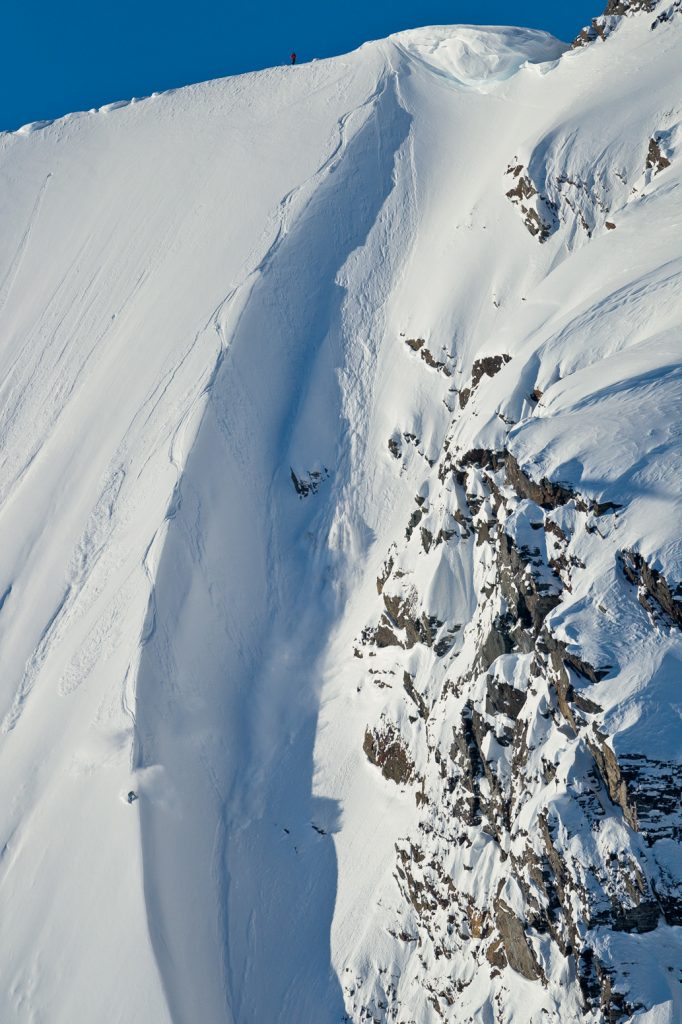
In the early ’90s, snowboard film company Standard Films pioneered these lines near Valdez, AK. TGR revisited the zone in 2013’s Dream Factory. Griffin Post dancing his way down Spinal Tap, a 2,500-foot curving spine he dissected with speed and precision.
Pushing the limits of his world hasn’t come without consequence, and Von Doersten has experienced more than his share of tragedy and close calls. He’s lost friends in mountaineering and ski accidents and plane crashes, and has been involved in rescue scenarios in which people didn’t make it. He came close to death on a 2002 expedition to Alaska’s Mount St. Elias. The plan was to make the world’s longest summit-to-sea ski descent with experienced ski and snowboard mountaineers Aaron Martin, Reid Sanders and John Griber. But high on the mountain, he broke a crampon and was forced to turn back. He developed frostbite on his hands during his scramble to safety before hunkering down in a snow cave while the others pushed on—a decision that potentially saved his life.
“Things weren’t going right,” Von Doersten says. “We had all these signs throughout the trip. We expressed some concern with the summit, that they were pushing too hard in less-than-prime conditions. They were going to ski this mountain. They ended up going up and things didn’t go as planned.”
Nearing the summit too late in the day, Griber decided to turn back as well. From below the summit he watched Martin slide off the side of the mountain to his death, realizing that the same had happened to Sanders minutes earlier. Their bodies were never found, and it took the Alaska Air National Guard to get Von Doersten and Griber off the mountain safely. While it’s still tough to think about, this tragedy helped Von Doersten shape a healthy concept of death, as well as the ability to celebrate the lives of friends and family lost.
“While traveling the world, the view of death in each culture and religion is perceived differently,” he says. “I applied some of these beliefs with my own philosophies on death and realized we all live on in the afterlife in some shape or form.”
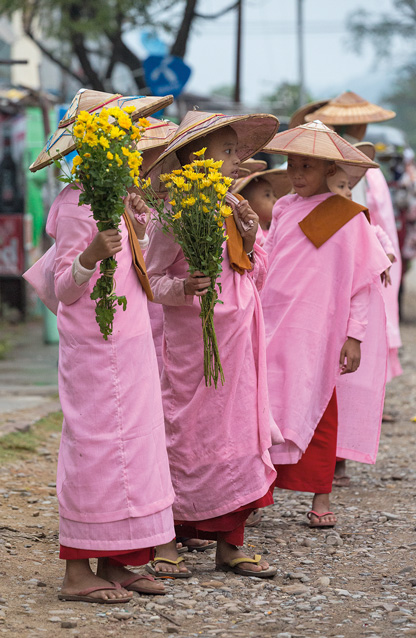
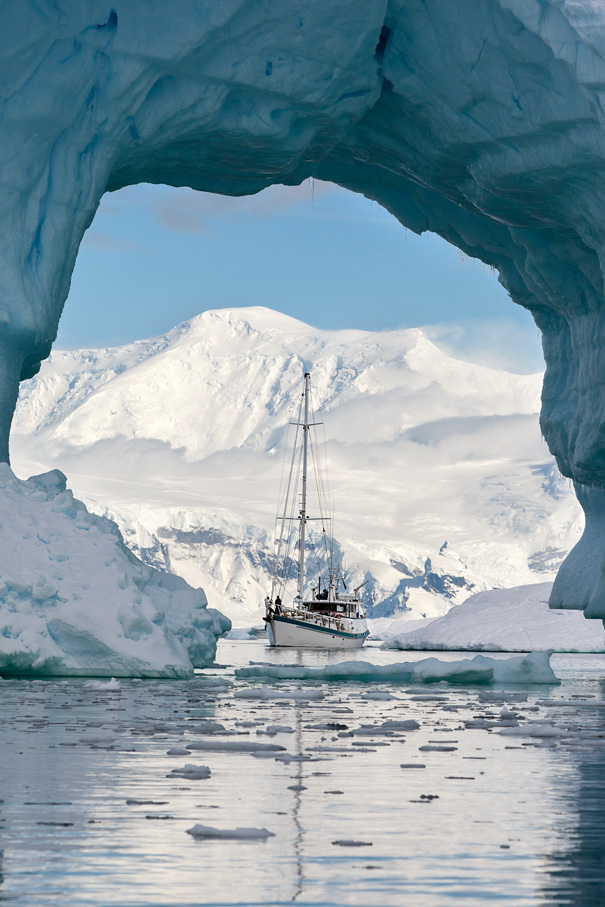
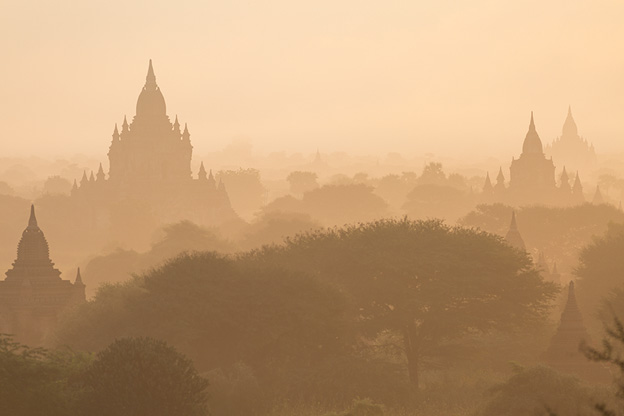
top to bottom
The Pink Robes in Myanmar signify young female monks from the age of 10 and upward that have left a life of poverty and devoted their lives to Buddhism and monastic living. Hsipaw, Myanmar.
RV Australis stands under a natural tabular iceberg arch, which is formed from the wind and water eroding its flanks. We had searched over 21 days to find this particular feature off the coast of Antarctica and ended up shooting a number of motion film and photographs to capture its beauty.
Mystical Myanmar in its finest colors and light near Bagan Myanmar. I woke up every morning at 5:00 a.m. to experience the early light and morning culture around the village—ox-drawn wagons hailed by farmers and people calling to their family and friends to honor the day ahead. It’s moments like this that instill the lifelong pursuit to travel and experience cultures and traditions while they are still thriving. My father always told me, “You can learn more from experiencing other cultures and religions then any formal education can offer you.” Those words have been a testament to my path in life.
This hard-earned perspective has traveled with Von Doersten on subsequent trips—projects such as a sailing and ski mountaineering expedition to Antarctica with Chris Davenport for Outside magazine, Red Bull’s Congo Grand Inga Project, and climbing and skiing the Grand Teton with 14-year-old Kai Jones, Todd Jones’ son, in June 2021.
On all these expeditions, he thinks back to the stories of Ernest Shackleton and other explorers he read as a child. The daring exploits portrayed in these stories help fuel Von Doersten to not only document the journey, but also to search out ways to get the innovative, never-before-seen shot.
In recent years, the now 57-year-old Von Doersten has leaned into commercial photography in addition to work in documentary film production and location scouting. He’s continually researching and pitching the next project—an unending push to stay relevant and change with the fast-evolving world of outdoor photography. He knows that as long as he can find the places where adventure and story meet, his search will keep marching on.
“I’m always looking forward,” Von Doersten says. “The next photo could be your most iconic image.”
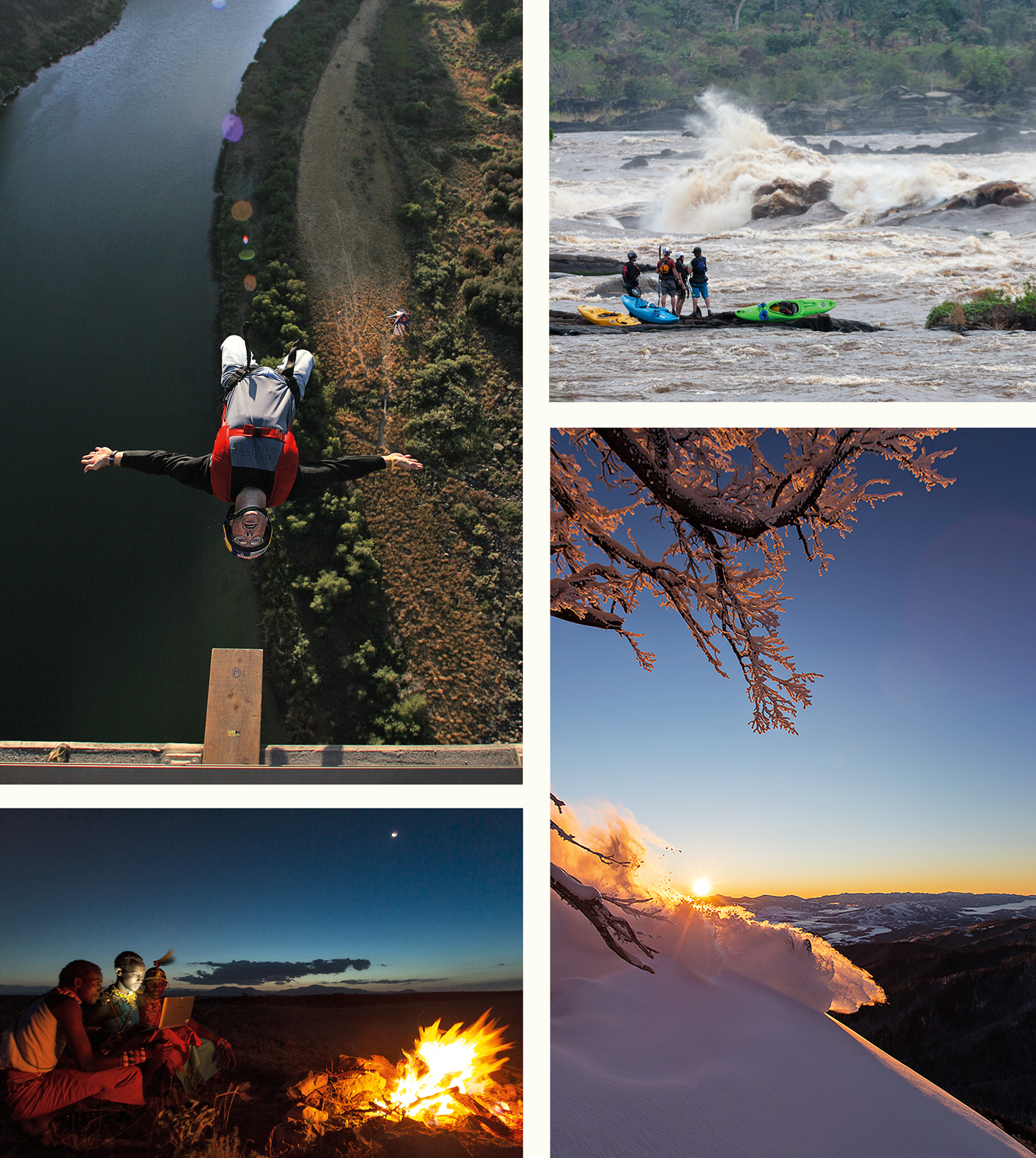
clockwise from top left
In 2005, I documented Miles Daisher setting the record for the most human-powered BASE jumps in 24 hours off the Perrine Bridge, in Twin Falls, ID (57 jumps in a single day). In 2017, he would return to set a new record of 63.
Whitewater expedition kayakers Rush Sturges, Ben Marr, Steve Fisher and Tyler Bradt scout the Grand Inga rapids, the largest rapid features in the world on the Congo River in the Democratic Republic of Congo. We scouted and planned for more than seven years before we were granted permission to film the award-winning documentary, Congo: The Grand Inga Project with Red Bull in 2013.
Early morning missions are some of my favorite moments to capture the action and soft alpenglow light. Danny Suarez nose butter 360 into a powder turn at sunrise, Jackson Hole backcountry, WY.
Some of my most rewarding work has come from projects aligned with social, environmental and human-based causes. This shoot was in conjunction with one of the original cofounders of TGR, Dirk Collins, for Mawingu, a company founded to provide internet and charging stations for East Africans at a fraction of the cost of cellular service. Here a group of Samburu herders in Kenya use the Mawingu broadband service to connect with other camel herders to sell their stock at the Saturday market to ensure sales and profitability before making the 50-mile trek.
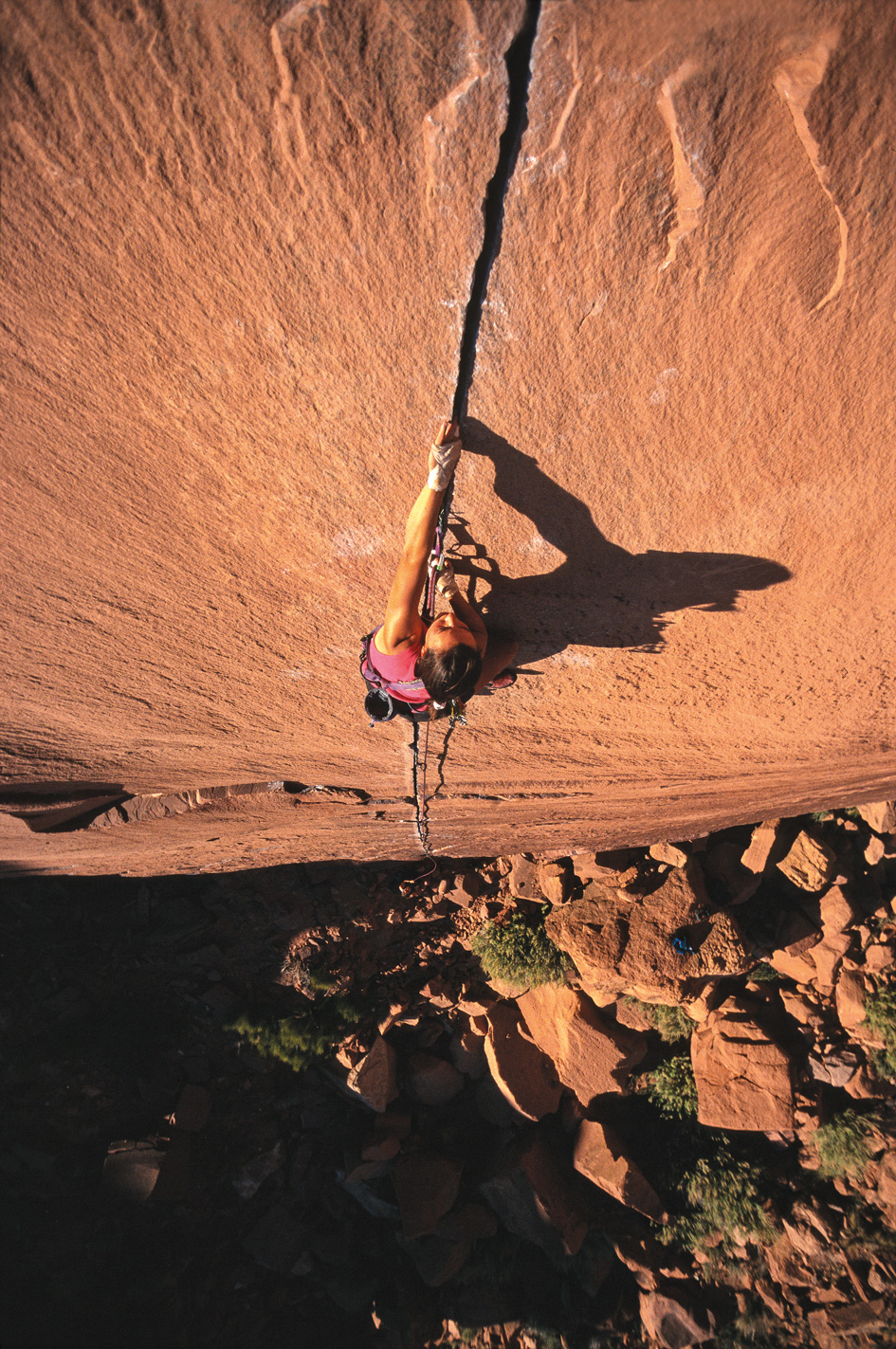
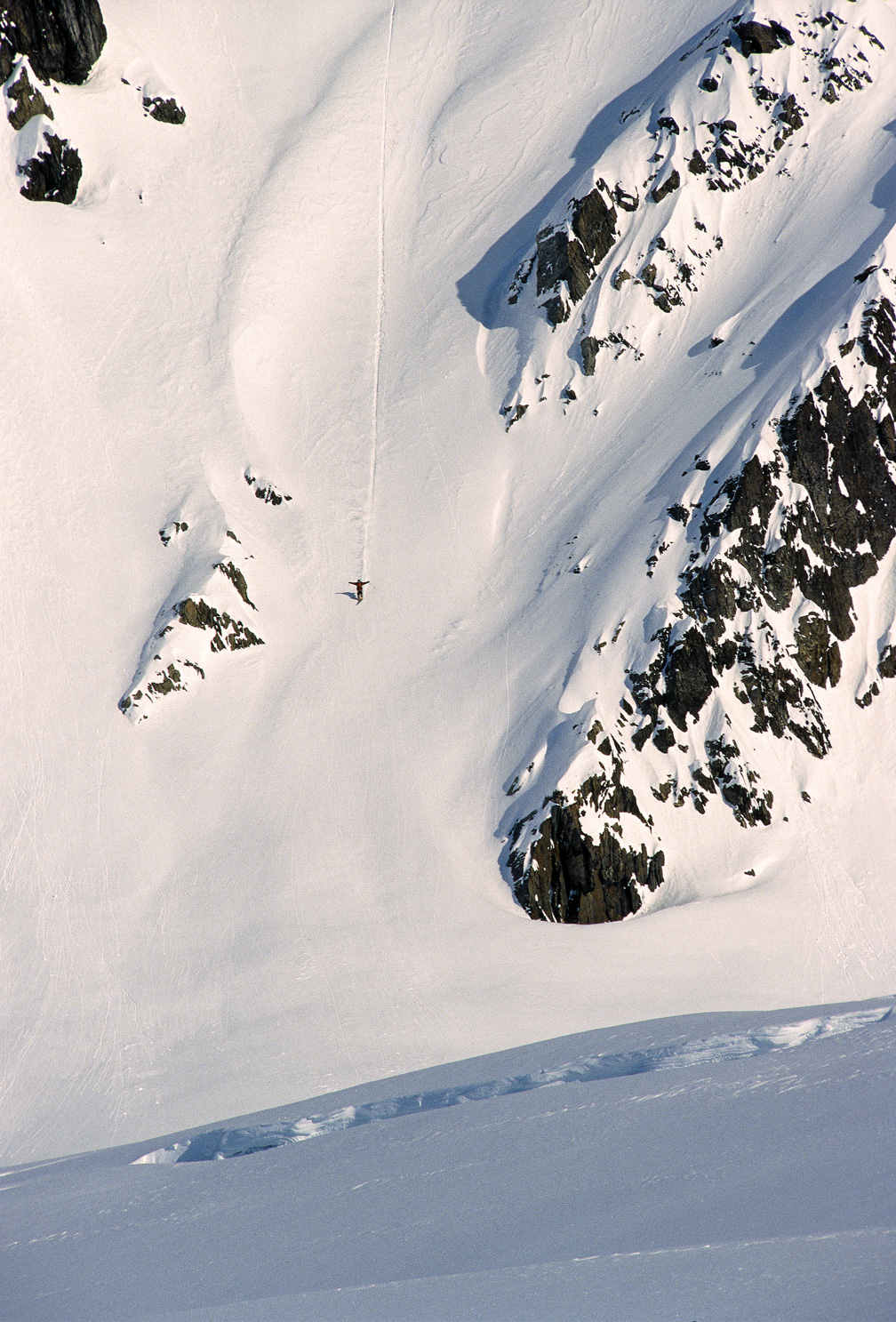
top to bottom
Steph Davis on Johnny Cat, a 5.11D in Utah’s Bears Ears National Monument. Davis continues to break boundaries in climbing, BASE and wingsuit flying as well as mentoring women climbers and promoting veganism.
Shane McConkey straight lines Python Peak in Valdez, AK. I often think about what Shane would be doing today. There’s little doubt he would still be leading the way, charging and progressing the sport of skiing and pushing all of the youth to continue exploring what’s possible on snow. He was an innovator on the cutting edge of freeskiing and BASE jumping, but was also one of the funniest people to work with in our sport.
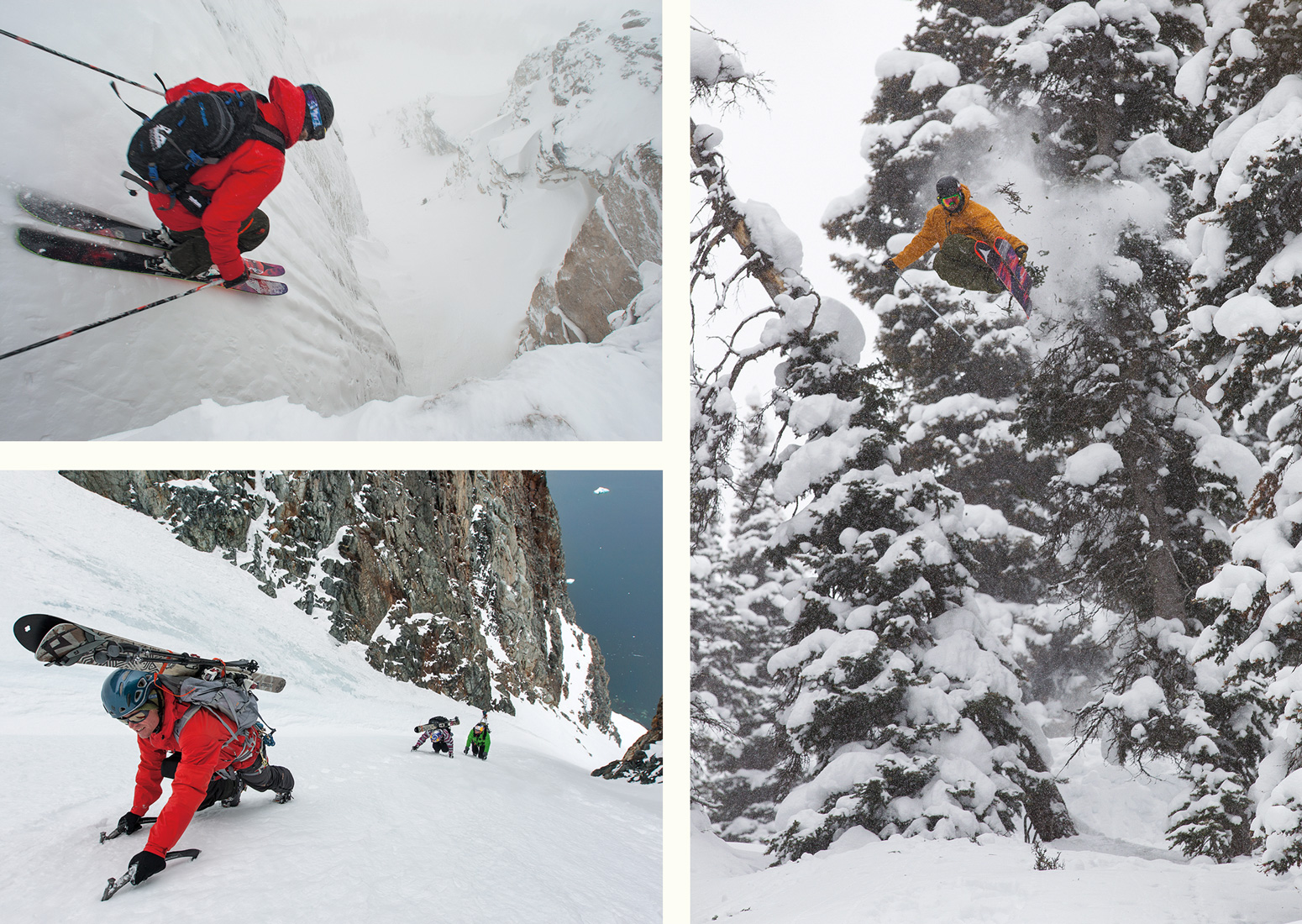
clockwise from top left
Todd Ligare might be one of my favorite skiers to shoot with because of his “get the shot” attitude. I used a remote camera in the Jackson Hole backcountry to capture the view from the athlete’s perspective and avoid pissing off TGR director Todd Jones by being in the way.
Nick McNutt has the ability to make magic from any location with his creative nose butters, tree taps and switch landings. This was one of those instances when McNutt was going off all day long in his early days shooting with TGR. Salt River Range, ID.
If there’s one exotic ski mountaineering location that stands out for me it has to be the Antarctica Peninsula. I planned the logistics and permits for this trip with Ocean Expeditions captain Ben Wallis on RV Australis, a 75-foot motor sailing yacht that is built for the adversity of the Southern Ocean. We eventually filmed, Australis—An Antarctica Ski Odyssey with Stian Hagen, his wife Andrea Binning and Chris Davenport, all pictured here.
